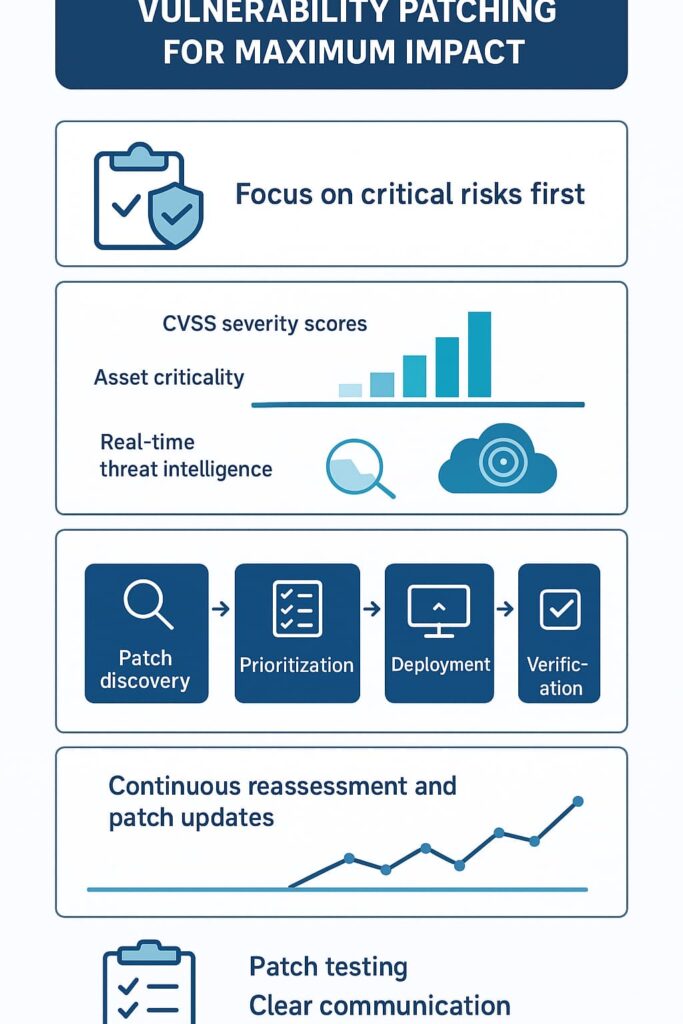Address
304 North Cardinal St.
Dorchester Center, MA 02124
Work Hours
Monday to Friday: 7AM - 7PM
Weekend: 10AM - 5PM
Address
304 North Cardinal St.
Dorchester Center, MA 02124
Work Hours
Monday to Friday: 7AM - 7PM
Weekend: 10AM - 5PM

Prioritizing security patches might sound tedious, but it’s like triage in an emergency room, you’ve got to know which problems need attention first. The real challenge isn’t finding the vulnerabilities (there’s probably hundreds of them right now), it’s figuring out which ones could actually hurt your business.
Nobody’s got time or money to fix everything at once, and honestly, some bugs just don’t matter that much. Smart companies rank their weak spots based on what could damage their most valuable assets, whether that’s customer data or manufacturing systems. Using the right assessment tools makes this process way less painful, helping teams focus on what really needs fixing.
Want to see how this works in practice? Keep reading.
Let’s face it, patching isn’t exactly glamorous work. But doing it right means knowing which holes to plug first, and that’s where smart prioritization comes in. Most security folks start with CVSS scores, which basically grade how bad a vulnerability is on a scale
Pretty straightforward stuff. But here’s the thing: those numbers don’t mean much without context. A critical bug in your payroll system probably matters more than a severe one in the office printer network.
Real-world threats change the game too. When hackers start actively exploiting a weakness, that patch suddenly becomes way more urgent. And nobody’s got time to manually track all this stuff, good automation tools make a huge difference in staying on top of it all. The whole process needs constant tweaking as new threats pop up.
Here’s what really matters:
For MSSPs, the right mix of these attributes directly impacts client trust and retention. Standardizing how teams evaluate and prioritize vulnerabilities, as outlined in a comprehensive vulnerability management services guide, helps deliver consistent, measurable value.

CVSS scores (that’s Common Vulnerability Scoring System for the newbies) are pretty much the industry standard for rating how bad security holes are. The scoring looks at stuff like how easy it is to exploit and what kind of damage it could do. But don’t get too caught up in the numbers game.
Some perspective helps: a high-scoring bug in your coffee maker’s firmware probably isn’t as urgent as a medium-risk hole in your customer database. That’s where decent analysis tools earn their keep, helping blend the raw scores with real business impact.
Things change fast in security. A vulnerability that seemed minor yesterday might become critical when someone figures out how to exploit it. That’s why the scoring needs constant updates based on what’s happening in the real world.
MSSPs often combine CVSS with internal scoring models to better align remediation priorities with client-specific risk profiles. [1]
Every company’s got their crown jewels, those systems they absolutely can’t afford to lose. Some servers hold enough sensitive data to sink the business if breached, while others just keep the break room vending machine running. Smart patching means knowing which is which. Rating these systems isn’t just about their technical specs; it’s about what happens if they go down or get hacked.
The internet-facing stuff needs extra attention, that’s just common sense. Public web servers are like having your front door wide open, they’ll always be prime targets. Meanwhile, that old desktop in accounting that’s not even connected to the web? Probably not keeping anyone up at night. Most companies split their assets into tiers (usually three or four levels) based on how exposed they are to potential attacks.
Systems don’t stay the same for long. New apps get deployed, old ones retire, and suddenly what wasn’t important becomes critical. Take cloud migrations, they can completely flip which assets need the most protection. Good tracking means regularly updating those criticality ratings, not just setting them once and forgetting about them.
For MSSPs managing multiple client environments, dynamic asset tracking is key to scaling patching decisions efficiently.

Security threats move faster than a caffeinated squirrel. What’s safe on Monday might be under active attack by Wednesday. That’s why plugging into threat feeds matters, they tell us when vulnerabilities stop being theoretical and start being actual problems. When hackers start exploiting a weakness, that patch just got way more urgent. [2]
Sometimes vulnerabilities pop up with no warning (and no patch ready). These zero-days are like finding out your lock’s been picked before the locksmith’s even designed a fix. Good threat intel helps spot these early, so teams can at least put other protections in place while waiting for the real fix.
Most companies run on common platforms, Windows, Linux, maybe some cloud services. When a bug shows up in these widely used systems, it’s usually just a matter of time before someone tries to exploit it. Keeping tabs on platform-specific threats helps predict where the next problem might come from.
For MSSPs, integrating threat intel into patch workflows improves response time and keeps clients safe from emerging risks.
Manual patching is slow, error-prone, and difficult to scale. Automated vulnerability management tools handle discovery, assessment, and patch deployment. This frees teams from tedious tasks and accelerates remediation timelines.
These tools integrate with scanners and asset inventories to maintain an up-to-date picture of vulnerabilities. They can auto-prioritize based on severity, exploitability, and asset criticality. Then, patches can be rolled out in a controlled and consistent manner.
Automation reduces patch fatigue and helps ensure no critical flaws slip through the cracks. But it’s not just about speed, automation also provides audit trails and monitoring to verify patch success.
For MSSPs, automation enables standardized service delivery while lowering operational costs.

We can’t simply patch once and hope for the best. The vulnerability landscape constantly changes, new flaws are discovered, threat actors shift targets, and IT environments evolve. That’s why continuous reassessment is vital.
Our prioritization process is ongoing. We regularly update asset inventories, integrate fresh threat intel, and rescore vulnerabilities. This keeps our patching aligned with the current risk environment.
Continuous prioritization also helps manage alert fatigue by focusing attention on real, pressing threats rather than outdated or low-risk vulnerabilities. Services built around continuous vulnerability assessment promote a proactive, rather than reactive, security posture.
Prioritized patching workflows bring structure and clarity to what can otherwise be a chaotic process. We start by mapping out all IT infrastructure and rating asset criticality. This asset inventory is foundational.
Next, vulnerability assessments identify and classify flaws across the environment. Using combined scoring that blends CVSS, business impact, and threat intelligence, we rank vulnerabilities by risk.
This ranking guides remediation efforts. High-risk vulnerabilities get immediate attention, while lower-priority ones can be scheduled accordingly.
Post-remediation, we review patch effectiveness through audits and monitoring. This feedback loop drives continuous improvement in our strategy.
For MSSPs, standardized workflows improve visibility and client reporting, demonstrating measurable value and compliance alignment. Effective managed vulnerability management plays a key role in refining these workflows and ensuring consistent, scalable results.
Credits: ISACA HQ
The Common Vulnerability Scoring System remains a core framework for severity scoring. It provides a standardized baseline, but it’s most effective when supplemented with business context and threat intelligence.
Risk-Based Vulnerability Management (RBVM) is a modern approach that integrates these elements seamlessly. It continuously adjusts risk scores based on external and internal factors, optimizing patch workflows.
Automated patch management solutions complement RBVM by speeding up deployment, especially for critical or internet-facing assets. These tools help us keep pace in a fast-moving threat environment.
For MSSPs evaluating tools, vendor-neutral consulting can reduce tool sprawl, optimize integrations, and ensure chosen solutions align with business maturity and client needs.
Asset criticality plays a major role in vulnerability assessment because not all systems have the same business impact. A server hosting customer data needs a different remediation timeline than a test environment.
By combining asset inventory data with vulnerability scanners and CVSS scores, teams can perform risk-based patching. This helps avoid patch fatigue by focusing on critical systems, reducing operational risk while meeting compliance requirements and maintaining cyber hygiene.
Threat intelligence provides real-time threat context by showing which external threats are active. Exploitability scores and exploit prediction scoring help identify known exploited vulnerabilities from sources like the CISA KEV catalog.
By linking this data with vulnerability classification and attack vectors, teams can make smarter decisions. This drives risk prioritization, improves exploit mitigation, and speeds up the remediation workflow through orchestrated response efforts and continuous monitoring.
Zero-day threats have no existing security updates, so delaying a patch increases exposure. Even strong compensating controls like network segmentation and endpoint security may not fully block advanced attack surface exploitation.
Patch automation and strict patch policy rules reduce the remediation timeline. Delays can lead to security incidents, breach prevention failures, and increased audit trail findings. Immediate risk communication and cross-functional teams are needed to plan patch rollout safely.
When many software vulnerabilities are discovered, resource allocation becomes a challenge. Risk scoring models, vulnerability triage, and business impact analysis help create a prioritization framework. Teams can use patch management tools with dashboard reporting and data enrichment to track patch deployment progress.
System prioritization and baselining assets reduce confusion, while vulnerability suppression filters out false positives. This enables prioritized remediation and clearer risk acceptance decisions with proper remediation oversight.
Patch deployment is more than just installing security updates. It requires patch testing to avoid breaking critical systems, configuration management to track changes, and scanner integration for validation.
A structured remediation process includes vulnerability lifecycle tracking, patch automation, and patch compliance checks. Patch validation, vulnerability database references like the CVE catalog, and vulnerability metrics help improve system hardening and breach prevention while reducing exposure management risks.
Prioritizing vulnerability patching takes both data and judgment. By combining severity scores, asset importance, and real-time threat intel, teams can focus on the most critical risks first.
Automation and continuous reassessment keep patching efficient, while structured workflows prevent wasted effort. This shifts patching from a last-minute scramble to a proactive, repeatable process.
Streamline your MSSP operations with expert consulting to reduce tool sprawl, improve visibility, and optimize your security stack.